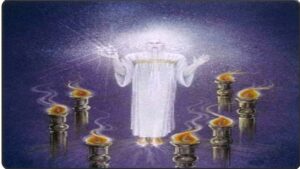- Christ empowers and intercedes His church (1:12-13, 20).
Hearing the voice behind him, John turned to see its source. He first saw 7-golden lampstands identified as the 7-churches. The lampstands are golden because gold was the most precious metal, so the Church is God’s most beautiful entity on earth. Seven is the number of completeness. The 7-churches symbolize the churches in general.
In the middle of the lampstands John saw “one like a Son of Man (7:13), the glorified Lord. He was clothed in a robe reaching to the feet with a golden sash across His chest. The picture represents as High Priest. As our High Priest, Christ once offered the perfect and complete sacrifice for our sins and now permanently, faithfully intercedes for us (Rom.8:33-34).

Christ standing in the middle of 7-lampstands
- Christ purifies His Church and speak authoritatively: (1:14-15):
John’s description of “Christ’s head and hair as white like white wool, like snow” similar to (Dan.7:9) affirms Christ’s deity. It symbolizes Christ’s eternal holy truthfulness. His eyes were “like a flame of fire”, “His searching gaze penetrates to the very depths of His church,” revealing with piercing clarity and reality of everything there is to know. Christ’s feet were “like burnished bronze, when it has been made to glow in a furnace,”is a clear reference to judgement on sinners in the church. His voice was now “like the sound of many waters,” a familiar analogy to the surf crashing on the rocky shores of Patmos in a storm. The voice of the eternal God was similarly described in Ezekiel 43:2, showing another parallel affirming Christ’s deity.
- Christ controls and protects His church: (1:16, 20):
Christ holding seven stars in His right hand, identified in (1:20) symbolizes His authority. The seven angels could be seven spiritual leaders in the church. They are to be instruments through which Christ mediates His rule. That is why the standards for leadership in the New Testament are so high. The sharp two-edged sword that came “out of His mouth” is used to defend the church against external threats. Here it speaks primarily of judgement against enemies from inside the church. Those who attack Christ’s church, sow lies, create discord or otherwise harm His people will be personally dealt with by the Lord of the church. His sword is potent (Heb.4:12-13) and will be used against the enemies of His people. “His face was shining” indicates that the glory of God through Christ shines in and through His church, reflecting His glory to the world (2 cor.4:6).
- The effects of the vision: (1:17-18)
When John I saw Jesus ,he fell at His feet as though dead. Paul was struck to the ground in a similar way when he saw Christ in His glory (Acts 9:4).
- Fear: John received reassurance from Christ in the words, do not be afraid. Christ stated that He is the eternal One, the First and the Last and the resurrected One, the Living One, who though once dead is now alive forever and ever! Here Christ affirmed that He alone has the keys of death and hades that is, authority over death and the place of the dead.
- Assurance: (1:17b-18): God placed His right hand John. The comfort Jesus offered was based on His person and His authority. First He identified Himself as “I am,” the covenant name of God (Ex.3:14). Secondly Jesus identified Himself as “the first and last”a title used of God in the Old Testament. Thirdly Jesus claimed to be “the living One”(Jn.1:4). God is the eternal, uncreated, self existent.
The Command to write: (1:19-20):
Following the revelation of Christ in glory, John was again commanded to write. The subject of his record has three tenses: (a) what he had already experienced: what you have seen; (b) the present experiences: what is now; and (c) the future: what will take place later. This appears to be the divine outline of Revelation. What John was told to write was first a record of his experience (chap. 1), now history. Then he was to write the present message of Christ to seven churches (chaps. 2-3). Finally, the main purpose of the book being prophetic, he was to introduce the events preceding, culminating in, and following the second coming of Christ (chaps. 4-22).In Revelation a symbol of vision is often presented first, and then its interpretation is given. So here the seven stars were declared to be the angels or messengers of the seven churches, and the seven lampstands are the seven churches themselves. The Book of Revelation, instead of being a hopeless jumble of symbolic vision, is a carefully written record of what John saw and heard, with frequent explanations of its theological and practical meanings.
Revelation, with assistance from such other symbolic books as Daniel and Ezekiel, was intended by God to be understood by careful students of the entire Word of God. Like the Book of Daniel, it will be better understood as history unfolds. Though timeless in its truth and application, it is a special comfort to those who need guidance in the days leading up to Christ’s second coming.
Before unfolding the tremendous prophetic scenes of chapters 4-22, Christ first gave a personal message to each of the seven churches with obvious practical applications to His church today.